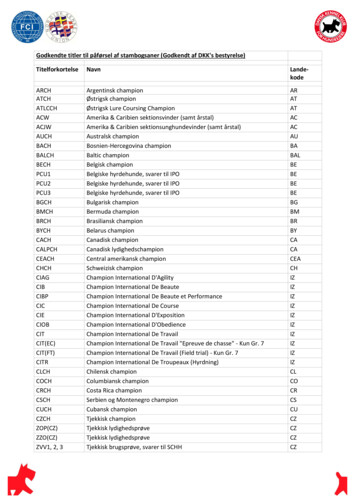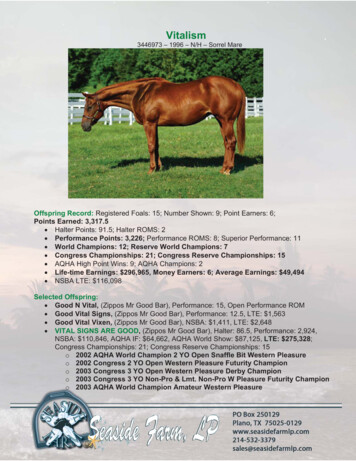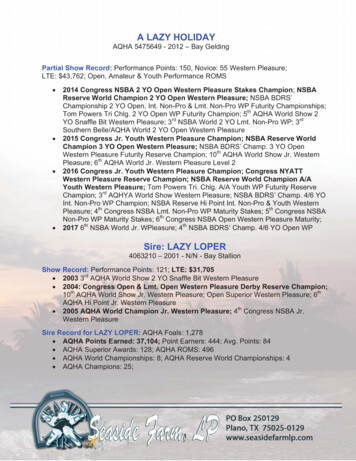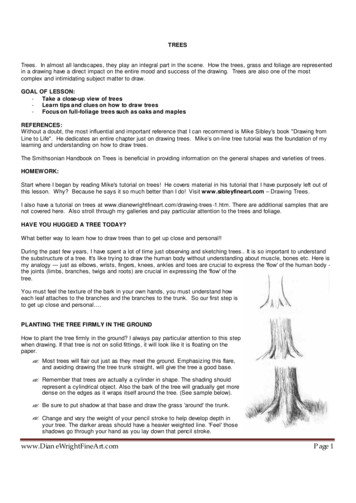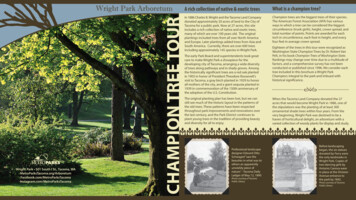
Transcription
A rich collection of native & exotic treesWhat is a champion tree?In 1886 Charles B. Wright and the Tacoma Land Companydonated approximately 20 acres of land to the City ofTacoma for a public park. Now at 27-acres, this siteincludes a rich collection of native and exotic trees,many of which are over 100 years old. The originalplantings included trees from all over North Americaand Europe. Later plantings added trees from Asia andSouth America. Currently, there are over 600 treesincluding approximately 145 species in Wright Park.Champion trees are the biggest trees of their species.The American Forest Association (AFA) has variousways in which a tree can be considered the biggest:circumference (trunk girth), height, crown spread, andtotal number of points. Points are awarded for eachinch in circumference, each foot in height, and everyfour feet in average crown spread.CHAMPION TREE TOURWright Park ArboretumThe early Park Board and superintendents took greatcare to make Wright Park a showpiece for thedeveloping city of Tacoma, arranging a wide diversityof trees along pathways and in shady groves. Amongthe historically significant trees are a red oak plantedin 1903 in honor of President Theodore Roosevelt’svisit to Tacoma, a gray birch planted in 1929 to honorall mothers of the city, and a giant sequoia planted in1939 in commemoration of the 150th anniversary ofthe adoption of the U.S. Constitution.The original planting plan has been lost, but we canstill see much of the historic layout in the patterns ofthe old trees. These patterns have been respectedthroughout park improvements and renovations overthe last century, and the Park District continues toplant young trees in the tradition of providing beautyand diversity for all to enjoy.Wright Park 501 South I St., Tacoma, nal landscapedesigner Edward OttoSchwagerl “saw thebeauties in what was toothers an apparentlyunwieldy piece ofnature.” - Tacoma DailyLedger of May 12, 1890Photo courtesy of TacomaPublic LibraryEighteen of the trees in this tour were recognized asWashington State Champion Trees by Dr. Robert VanPelt, in his book Champion Trees of Washington State.Rankings may change over time due to a multitude offactors, and a comprehensive survey has not beenconducted or published since 1996. We consider eachtree included in this brochure a Wright ParkChampion; integral to the park and imbued withhistorical significance.When the Tacoma Land Company donated the 27acres that would become Wright Park in 1886, one ofthe stipulations was the planting of at least 300ornamental shade trees within four years. From thevery beginning, Wright Park was destined to be ahaven of horticultural delight, an arboretum with avaried collection of woody plants for display and study.Before landscapingbegan, the six statuesdonated by Ferry werethe only landmarks inWright Park. Copies oftwo dancing girls byAntonio Canova werein place at the DivisionAvenue entrance tothe park by 1892.Photo courtesy of TacomaPublic Library
Seasonally Spectacular!The many benefits of trees Trees remove contaminants and particulates fromthe air, improving air quality by absorbing potentiallyhazardous gases and reducing particulates createdby heavy traffic and industrial activity. By filtering greenhouse gases such as carbondioxide out of the atmosphere, trees contributeover time to cooling the air. One tree can producethe same cooling effect as 10 room-size airconditioners. Each tree absorbs hundreds of gallons of water,filtering it through the root system so clean watergoes back to the ground They also do things you might not measure such asslow traffic, reduce noise, and cool sidewalks toencourage walking.Hands on“A man has made at least a start on discovering the meaning of human life when he plants a shade tree under which he knows full well he will never sit.”- Elton TruebloodIn addition to this arboretum, Metro Parks has oldgrowth at Point Defiance Park, young forest at SwanCreek Park, oak woodlands at Oak Tree Park andWapato Hills Park, and wetlands at China Lake Parkand DeLong Park. This varied urban forest serves aneducational function as well as providing the social,environmental and health benefits of the urban forestas a whole. Stewardship activities, tours, events,classes and signs are a few of the many possibilities tolearn more about the forest.Wright Park is alsohome to W.W. SeymourBotanical Conservatory.It opened in 1908through a generous giftfrom William W.Seymour, President ofthe Metropolitan ParkBoard and later Mayorof Tacoma.Photo courtesy of TacomaPublic Library
Red OakQuercus rubraNative Habitat: Northeastern U.S.Planted 19031This specific tree is known as the TeddyRoosevelt Oak as it was planted in honorof President Theodore Roosevelt’s visit toTacoma in May of 1903.A symbol of strength, the oak became theofficial National tree of the United Statesin 2004. During the War of 1812, the Navyship USS Constitution took its nickname “OldIronsides” from the strength of its live oak hull,famous for repelling British cannonballs.Red oaks do not produce acorns until they areat least 20 years old. Acorns are an importantfood source for insects, squirrels, deer, and birds.Observe: The pointed lobes on the leaves, widereaching branches that provide shade, andridged bark resembling ski tracks.Mockernut HickoryCarya tomentosaNative Habitat: Eastern half of U.S.Planted ca. 18952This tree has sweet-smelling leaveswith seven leaflets and gray, irregularlyfurrowed bark. Also called the WhiteHickory due to the light color of the wood,the tree’s common name of “Mockernut”comes from the large, thick-shelled fruitwith very small kernels of meat inside.Although the Mockernut Hickory growsvery slowly, it is long lived, sometimesreaching the age of 500 years. A highpercentage of the wood is used forproducts where strength, hardness, andflexibility are needed.Observe: The newer twigs and leafletscovered with fuzz, which explains its Latinname, tomentosa, meaning “dense softhairs.”
Red Maple3Acer rubrumNative Habitat: Eastern North AmericaPlanted ca. 1895Currently the most common species oftree in America, the Red Maple may havecomprised a mere 5% of forest area whenEuropeans first arrived here. Its abilityto thrive in a large number of habitats islargely due to its ability to produced rootsto suit its site from a young age. Also, deerleave maple seeds untouched so volunteerseedlings proliferate.It is extensively used as a city street treebecause of the ample shade the canopyprovides during hot summers followed by thevibrant color show just before the leaves fall.Observe: Its brilliant deep scarlet foliagein autumn. It is aptly named as its flowers,petioles, twigs and seeds are all red tovarying degrees.Caucasian AshFraxinus angustifoliaNative Habitat: EuropePlanted ca. 18954The common name of this narrow-leafed“ash” traces back to Old English “aesc”which means spear. The bark is smoothand pale gray on young trees, becomingsquare-cracked and knobby on old trees.Wood of the ash tree is strong and elasticat the same time. It is used for makingbows, tool handles, baseball bats, andelectric guitar bodiesFlowering occurs in early spring. The seeds,popularly known as “keys” or “helicopterseeds,” are a type of fruit known as asamara.Observe: The buds are pale brown, whichreadily distinguishes it from the relatedFraxinus excelsior (black buds) even inwinter.
Paper Birch5Betula papyriferaNative Habitat: Northern North AmericaPlanted ca. 1895The name “papyrifera” comes from theGreek “papurus” (paper) and the Latinword “fero” (to bear, carry, bring).The distinctive white paper-like bark ishighly weather-resistant due to its highoil content. Native Americans used theflexible, waterproof bark for canoes,teepee covers and baskets. Its wood isnow used commercially for toothpicks andPopsicle sticks.Observe: The bark is white, flaking in finehorizontal strips, and often with smallblack marks and scars. In individualsyounger than five years, the bark appearsbrown with white lenticels, making thetree much harder to distinguish.European AshFraxinus excelsiorNative Habitat: EuropePlanted ca. 18956This is a large deciduous tree growing to65-114 ft. tall with a trunk diameter up to6 ft. and a tall, domed crown. In Europeanfolklore, Yggdrasil is a legendary ash treeknown as the World Tree. It was said thatits roots reached down into hell while itscrown touched the heavens, its huge trunkconnecting the two.The bark is smooth and pale gray onyoung trees, becoming thick and verticallyfissured on old trees. This tree has highlyflexible wood which is used for bows, toolhandles and walking sticks.Observe: The jet black buds in spring whichdistinguish it from most other ash species,which have gray or brown buds.
Plume Sawara Cypress7Chamaecyparis pisiferaNative Habitat: Central & Southern JapanPlanted ca. 1895This slow-growing coniferous evergreentree is cultivated for its timber in Japan,where it is used as a material for buildingpalaces, temples, shrines and baths, andmaking coffins. The wood is lemon-scentedand light-colored with a rich, straightgrain, and is rot resistant.Also a popular ornamental tree in parksand gardens, this tree is a cultivatedvariety that does not grow in the wild.Female cones appear in autumn; malecones are borne in spring.Observe: The peeling bark is red-brown,vertically fissured and with a stringytexture. Fine-textured medium greenneedles are tinted white beneath.Spanish ChestnutCastanea sativaNative Habitat: Europe & AsiaPlanted ca. 18958This long lived deciduous tree grows talland strong. The bark often has a net-shapedpattern with deep furrows or fissures runningspirally in both directions up the trunk. Thesmall female flowers form strongly scenteddrooping clusters that mature into thornyshelled fruits which contain energy rich ediblenuts (chestnuts). Roasted chestnuts are awell-known Christmas treat in Europe.This tree requires mild climate and adequatemoisture for good growth and a good nutharvest. Its current year’s growth (but not therest of the tree) is sensitive to late springand early autumn frosts, and is intolerantof lime.Observe: The leaf edges which resemblesaw-blade teeth.
American Chestnut9Castanea dentataNative Habitat: Eastern North AmericaPlanted ca. 1895It is estimated that approximately 3 billionAmerican Chestnut trees were destroyedin the first half of the 20th century by theairborne fungal disease chestnut blight afterits initial discovery in 1904. Fortunately, thisis a rapidly growing deciduous hardwoodtree and a prolific bearer of nuts.This tree is a valuable food source for wildlife.It also contains more nitrogen, phosphorus,potassium and magnesium in its leaves thanmany other trees which means they returnmore nutrients to the soil.Observe: It can be best identified by thelarger, more widely spaced saw-teethon the edges of its leaves, as indicatedby the scientific name dentata, Latin for“toothed.”Giant Sequoia10Sequoiadendron giganteumNative Habitat: Sierra Nevada MountainsPlanted 1939This specific tree was planted incommemoration of the 150th anniversaryof the adoption of the U.S. Constitution.Named after Sequoyah (1767-1843), theinventor of the Cherokee syllabary, sequoias arethe world’s largest single trees, growing to anaverage height of 164-279 ft. and 20-26 ft. indiameter. They supplement water from the soilwith fog, taken up through air roots to heightswhere the root water cannot be pulled.They are also among the oldest living thingson Earth with the oldest known giant sequoiabased on ring count being over 3,500 years old.Observe: Sequoia bark is fibrous andfurrowed and provides significant fireprotection for the trees.
Coliseum MapleAcer cappadocicumNative Habitat: AsiaPlanted ca. 189511This is a medium-sized deciduous tree withshallowly grooved greenish-grey bark andbright green leaves that turn butter yellowin the fall. The leaf stems bleed a milkylatex when broken. Early spring flowers areyellow-green and very tiny. The resultingfruits are double-winged seeds calledsamaras. Unlike most maples, this speciesusually produces root suckers around thebase of the tree.Cappadocia is an ancient region of whatis now central Turkey where this tree wasdiscovered growing in the late 1700s.Observe: The beautiful, intricate branchnetwork, which is fully exposed in thewinter months.Rock ElmUlmus thomasiiNative Habitat: Midwestern U.S.Planted ca. 189512Narrower than average and with shortbranches, Rock Elms are also unusualamong North American elms in that theyoften have a single main stem.Due to a slow growth rate (averagediameter increase is 1/12 inch per year),they produce the hardest, heaviest wood ofany elm, remaining virtually free of knotsand defects. Wood from these trees wasonce in great demand for shipbuilding,furniture, agricultural tools, and musicalinstruments. While they can live up to 300years, Rock Elms are susceptible to Dutchelm disease.Observe: The bark is gray-brown and deeplyfurrowed into scaly, flattened ridges.
Silverleaf MagnoliaMagnolia hypoleucaNative Habitat: Southeast AsiaPlanted 193913This specific tree, grown from a Japaneseseed, was donated by Peter Faulk in 1939.Magnolia is an ancient genus with fossilizedspecimens of plants identifiably belonging tothe Magnoliaceae dated to 95 million yearsago. Appearing before bees did, this tree’slarge powerfully scented pale yellow/creamcolored flowers are theorized to have evolvedto encourage pollination by beetles. To avoiddamage from pollinating beetles, the carpelsof Magnolia flowers are extremely tough.Also known as the Whitebark Magnolia, thistree is highly tolerant of airborne pollutants.Observe: The leaves become skeletonizedafter they fall, leaving behind a fine net ofveins.Tulip Tree14Liriodendron tulipiferaNative Habitat: Eastern North AmericaPlanted ca. 1895The tulip tree is sometimes referred toas a yellow poplar, although it is moreclosely related to magnolia trees. The Latin“Liriodendron” actually means “lily tree.” Itgrows rapidly and its hard wood has highcommercial value for cabinet and furnitureframing.In the spring, if you look high enough, youcan see 2-3 inch yellow-green and orangeblossoms. The tree’s cone-like fruit maturesin late summer to early fall. Long after theleaves have fallen, the seed clusters, whichresemble wooden flowers, remain high inthe tree.Observe: Flowers (which start formingafter around 15 years) are similar to a tulipin shape, hence the tree’s name.
English Field MapleAcer campestreNative Habitat: EuropePlanted ca. 189515“Campestre” means from the fields. Alsocommonly called a hedge maple, it may bepruned to form a tall hedge. In England itis often included in hedgerows.As fall progresses, the sap flow slowsand chlorophyll, the chemical that givesthe leaves the leaves their green color inthe spring and summer, disappears. Theresidual sap becomes more concentratedas it dries. Depending on how much iron,magnesium, phosphorus, or sodium is inthe plant, leaves might turn amber, gold,red, orange or just fade from green tobrown.Observe: This is a deciduous tree withfinely fissured, often somewhat corky bark.Horse ChestnutAesculus hippocastanumNative Habitat: South East EuropePlanted ca. 189516Dozens of small white flowers appear oneach 8-12 inch branched cluster in thespring. The fruit is a green, spiky capsulecontaining 1-3 glossy-brown nuts.Although the tree is called a chestnut,the seeds are poisonous to humans andmany other mammals (including horses).However deer and squirrels can eat thembecause they can break down the toxins.In Britain and Ireland, the seeds are usedfor the popular children’s game conkers.Historically, many parts of the horsechestnut tree have been processed andused to treat various illnesses.Observe: The characteristic curled ends ofthe tree’s branches.
Pond CypressTaxodium ascendensNative Habitat: Southeastern U.S.Planted 196317This deciduous conifer tree is often found alongthe edges of streams and around the edge ofswampy ground where water is standing.The trunk is expanded at the base, assisting thetree in anchoring in soft, muddy soil. The deeplyfurrowed bark is a pale gray color.Like Bald Cypresses, Pond Cypressesgrowing in water have a characteristicgrowth trail called cypress knees; these arewoody projections (pneumatophores) sentabove the water from the roots, probablyenabling this plant to breathe air in habitatwith waterlogged soil. Maximum longevityof this plant is estimated at 1000 years.Observe: Bright green needles turn anattractive red-brown in autumn and fall offin winter.Sugar Maple18Acer saccharumNative Habitat: Northeastern CanadaPlanted ca. 1895A deciduous tree, the Sugar Maple is bestknown for its bright fall foliage and forbeing the primary source of maple syrup.Sugar Maples produce 5 to 60 gallons ofsap per year. It takes about 32 gallons ofsap to make each gallon of syrup.The sugar maple will generally beginflowering when it is between 10-15years old. The fruit has two winged seedswhich fall from the tree in autumn, wherethey must be exposed to 90 days oftemperatures below -18 C to break theircoating down.Observe: Its small grooved light-gray barkand slender twigs ranging from green/brown to gray. In the fall, see the clustersof double-winged seeds.
Montpelier Maple19Acer monspessulanumNative Habitat: Mediterranean RegionPlanted ca. 1895This is a medium-sized deciduous treewith smooth, dark gray bark on youngtrees, becoming finely fissured on oldtrees. The flowers are produced in spring,in pendulous yellow to white flat toppedclusters. The samaras (one seeded wingedfruit) have rounded nutlets.This tree is popular among bonsaienthusiasts due to its smallish leaves andshrubby habit.Observe: Among similar maples it is mosteasily distinguished by its small threelobed leaves which are a glossy dark greenwith a smooth margin. Its leaves also havea clear leaf sap (milky-white in the FieldMaple).English OakQuercus roburNative Habitat: EuropePlanted ca. 189520This is a large deciduous tree, with a widespreading crown of rugged branches.Flowering takes place in mid-spring.The fall fruit, the distinguishing acorn, isdispersed by jays and squirrels.Robus is Latin for “strength, hard timber.”The English Oak is considered “King ofTrees” symbolizing strength and duration.These trees can live for 1,000 years ormore. They have been a prized source oftimber since prehistoric times.Observe: The rounded lobes on the leaves,deep-ridged bark, and the scars thatremain on the trunk from previous limbtrimmings. Are the acorns in the tree or onthe ground?
Notes & Sketches
AcknowledgmentsWe would like to recognize Charles B. Wright and the Tacoma LandCompany for donating the original parcel of land for this park in 1886;as well as Edward O. Schwagerl who was originally commissionedto design Wright Park and E.R. Roberts who was hired in 1890 tocontinue the work Schwagerl started.In the present day, we recognize the current stewards of Wright Park;the Metropolitan Park District of Tacoma Board of Park Commissioners- Jessie K. Baines Jr., Erik Hanberg, Aaron Pointer, Tim Reid and AndreaSmith - and the many employees of Metro Parks Tacoma (MPT) underexecutive director Jack C. Wilson.In particular we want to recognize: Community & Neighborhood Parks Manager Joey Furuto and LeadJeff Pudists and their team of dedicated and skilled staff whomaintain Wright Park Natural Areas Manager Mary Anderson and Urban Forester MarkMcDonough who care for the trees in Wright ParkThe interpretive tree signage was installed by volunteer interns AustinAxtman, Kyle Hahn and Brad Anderson in 2016 under the direction ofUrban Forester Mark McDonough and former Natural Areas Manager,Joe Brady.The photographs in this booklet were taken by Lauren McKenna.Above all, the citizens of Tacoma merit special recognition for theirpassage of the 2005 Park Improvement Bond, which has funded themost comprehensive reinvestment in Wright Park’s infrastructure,facilities, and features since the park opened to horsedrawn carriagesin 1890. And for their passage of the 2014 Parks & Zoo Bond whichincludes funding for improvements and programming materials forthe Wright Park Arboretum as well as replacement of the bridge overthe pond and renovation and expansion of the Conservatory.
acres that would become Wright Park in 1886, one of the stipulations was the planting of at least 300 ornamental shade trees within four years. From the very beginning, Wright Park was destined to be a haven of horticultural delight, an arboretum with a varied collection of woody plants for display and study. Wright Park Arboretum CHAMPION TREE .


